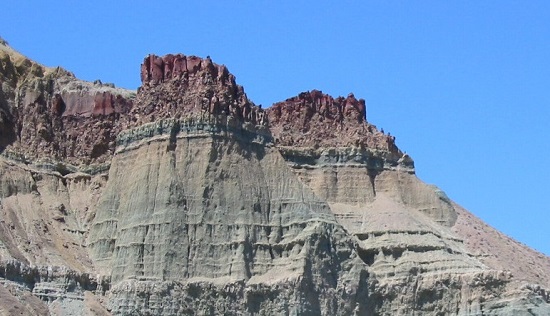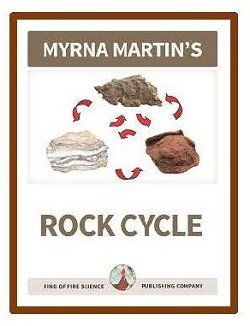Pyroclastic flows create ignimbrite
What is ignimbrite?
Deposits of pyroclastic flows
Ignimbrite is a volcanic rock consisting essentially of pumice and ash fragments deposited by pyroclastic flows. Ignimbrite forms during the eruption of large-volume ash flows or dense
clouds of incandescent rock fragments that are erupted at extremely high
temperatures. The rock particles from the ash flow fuse together as they fall
to the ground and solidify.
Pyroclastic flows
Pyroclastic flows
Pyroclastic flows flows
are one of the most dangerous natural events that occur on our planet. They can
travel at hurricane speeds down the slopes of a mountain, destroying everything
in their path. They travel at speeds up to 80 km/h. The temperature of the
rocks in the flows is between 200°C and 700°C.
Inside a pyroclastic flow
Pyroclastic flows carry tons of superheated materials down
the slope of a volcano in large eruptions. The pyroclastic flows destroy entire forests and manmade
structures in their path. They carry ash, lapilli, and lava bombs inside their
turbulent clouds which are almost silent. The only sounds are produced by the
collision of material within the cloud.Pyroclastic flows created by large eruptions can travel
over 100 km from their source.

Rattlesnake Formation of ignimbrite
The Rattlesnake Formation is the caprock in the picture. The rim rock was formed during a volcanic eruption about 7 million years ago. The volcano erupted hot ash, cinders and other debris that covers 33,669 sq km (13,000 sq miles) of eastern Oregon. The ignimbrite in the picture can be seen as the red rocks at the top that welded together to form the caprocks.
Dangers of Pyroclastic surges
Top of pyroclastic flow
A pyroclastic flow will develop a more diluted flow of
highly turbulent gases and ash at the top of the flow. This upper flow is
called an ash-cloud surge and moves even faster than the heavier fragments at
the bottom of the flow.
Front of pyroclastic flow
The superheated ash and gases move
in front of the denser materials. The lobes of an ash cloud surge forward
billowing out in front of the flow. Leading lobes of the flow will be overtaken
and surpassed as other lobes surge ahead.
Ash cloud surges
Ash cloud surges are more mobile
than the denser pyroclastic flow and can move over ridges instead of following
stream valleys down the mountain.


Click for More Information and to Order
Pyroclastic flows on Unzen volcano
Unzen Volcano in Japan
Unzen Volcano in
Japan was the source of over 10,000 pyroclastic flows between 1991 and 1995
that traveled up to 5.5 km from their source. Volcanologists set up monitoring
stations to study the pyroclastic flows.
Lava dome eruptions
The source of the pyroclastic flows was a lava dome that
began to form when viscous lava erupted at the summit starting in May 1991 on
the edge of a caldera. The dome grew on the edge of a steep slope located on
the east flank of the volcano.
Dome collapses on Unzen
Hot lava rocks broke off erratically forming pyroclastic
flows each time the dome collapsed. The avalanche of hot lava blocks cascaded
down the slope quickly becoming a fast-moving pyroclastic flow of super-hot
rock fragments and hot gases.
Surges on Unzen volcano
Pyroclastic flows followed the river valleys
The pyroclastic
flows followed the river valleys down the slopes of the volcano. Within seconds
after the pyroclastic flow started, surges formed at the top of the flows. The
surges were filled with ash-sized fragments of rock and superheated gases that
moved in front of the slower moving flow on the bottom.
Surges flowed down valleys and over ridges
Surges traveled both down the valleys and over the
ridges of the volcano. Several times each day these pyroclastic flows traveled
several kilometers down the mountain to the base of the volcano.
19 People were killed by surges in 1991
Nineteen people were killed in June 1991 by pyroclastic
flows. Three geologists, newspaper reporters and other people were killed near
the summit of the mountain. The group were walking up one of the valleys on
Unzen to take pictures when a surge flowed over a ridge killing the 19 people
in the party. Three newspapers printed pictures of the eruption that were taken
by newspaper reporters on the mountain after their cameras were recovered.
Novarupta eruption
June 1912 eruption
June 6,1912 the Novarupta volcano began erupting voluminous
amounts of pyroclastic material into the air. The eruption contained molten
rock and ash from the magma chambers of Novarupta and nearby Katmai volcano.
Largest eruption of the 20th century
Magma beneath the summit of Katmai volcano drained out
of the magma chamber. The lava flowed several kilometers to Novarupta. The two
magma chambers combined to produce the largest eruption of the 20th
century.
The eruption produced pyroclastic flows that filled a valley 20 km long and 3 km wide with ash and pumice. Scientists named the area The Valley of 10,000 Smokes.
KIDS FUN Science Bookstore
Check out Myrna Martin's award winning textbooks, e-books, videos and rock sets. The Kids Fun Science Bookstore covers a wide range of earth science topics. Click here to browse.










